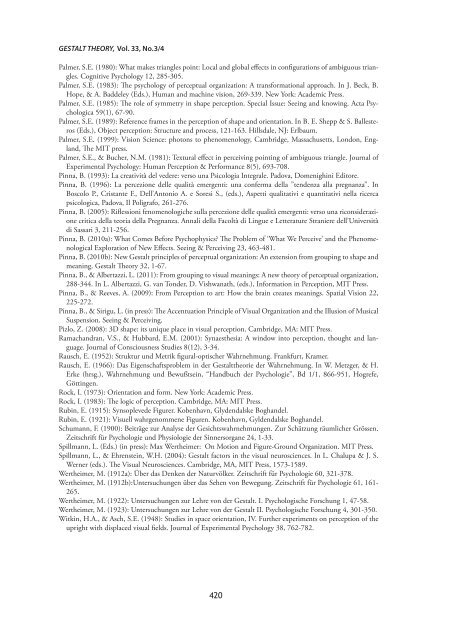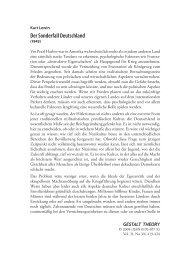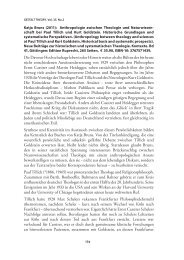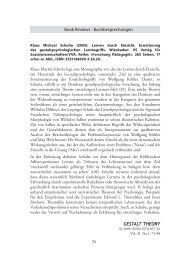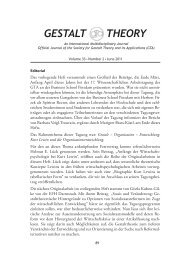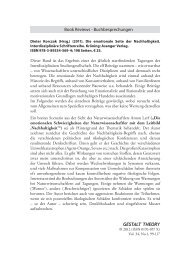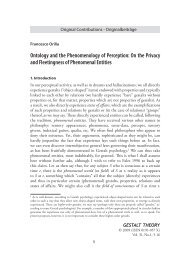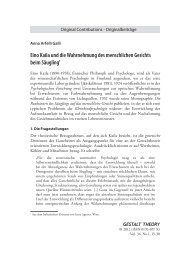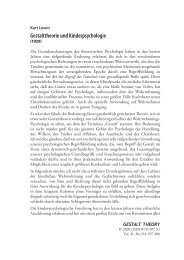What is the Meaning of Shape? - Gestalt Theory
What is the Meaning of Shape? - Gestalt Theory
What is the Meaning of Shape? - Gestalt Theory
You also want an ePaper? Increase the reach of your titles
YUMPU automatically turns print PDFs into web optimized ePapers that Google loves.
GESTALT THEORY, Vol. 33, No.3/4<br />
Palmer, S.E. (1980): <strong>What</strong> makes triangles point: Local and global effects in configurations <strong>of</strong> ambiguous triangles.<br />
Cognitive Psychology 12, 285-305.<br />
Palmer, S.E. (1983): The psychology <strong>of</strong> perceptual organization: A transformational approach. In J. Beck, B.<br />
Hope, & A. Baddeley (Eds.), Human and machine v<strong>is</strong>ion, 269-339. New York: Academic Press.<br />
Palmer, S.E. (1985): The role <strong>of</strong> symmetry in shape perception. Special Issue: Seeing and knowing. Acta Psychologica<br />
59(1), 67-90.<br />
Palmer, S.E. (1989): Reference frames in <strong>the</strong> perception <strong>of</strong> shape and orientation. In B. E. Shepp & S. Ballesteros<br />
(Eds.), Object perception: Structure and process, 121-163. Hillsdale, NJ: Erlbaum.<br />
Palmer, S.E. (1999): V<strong>is</strong>ion Science: photons to phenomenology, Cambridge, Massachusetts, London, England,<br />
The MIT press.<br />
Palmer, S.E., & Bucher, N.M. (1981): Textural effect in perceiving pointing <strong>of</strong> ambiguous triangle. Journal <strong>of</strong><br />
Experimental Psychology: Human Perception & Performance 8(5), 693-708.<br />
Pinna, B. (1993): La creatività del vedere: verso una Psicologia Integrale. Padova, Domenighini Editore.<br />
Pinna, B. (1996): La percezione delle qualità emergenti: una conferma della ”tendenza alla pregnanza”. In<br />
Boscolo P., Cr<strong>is</strong>tante F., Dell’Antonio A. e Soresi S., (eds.), Aspetti qualitativi e quantitativi nella ricerca<br />
psicologica, Padova, Il Poligrafo, 261-276.<br />
Pinna, B. (2005): Riflessioni fenomenologiche sulla percezione delle qualità emergenti: verso una riconsiderazione<br />
critica della teoria della Pregnanza. Annali della Facoltà di Lingue e Letterature Straniere dell’Università<br />
di Sassari 3, 211-256.<br />
Pinna, B. (2010a): <strong>What</strong> Comes Before Psychophysics? The Problem <strong>of</strong> ‘<strong>What</strong> We Perceive’ and <strong>the</strong> Phenomenological<br />
Exploration <strong>of</strong> New Effects. Seeing & Perceiving 23, 463-481.<br />
Pinna, B. (2010b): New <strong>Gestalt</strong> principles <strong>of</strong> perceptual organization: An extension from grouping to shape and<br />
meaning. <strong>Gestalt</strong> <strong>Theory</strong> 32, 1-67.<br />
Pinna, B., & Albertazzi, L. (2011): From grouping to v<strong>is</strong>ual meanings: A new <strong>the</strong>ory <strong>of</strong> perceptual organization,<br />
288-344. In L. Albertazzi, G. van Tonder, D. V<strong>is</strong>hwanath, (eds.), Information in Perception, MIT Press.<br />
Pinna, B., & Reeves, A. (2009): From Perception to art: How <strong>the</strong> brain creates meanings. Spatial V<strong>is</strong>ion 22,<br />
225-272.<br />
Pinna, B., & Sirigu, L. (in press): The Accentuation Principle <strong>of</strong> V<strong>is</strong>ual Organization and <strong>the</strong> Illusion <strong>of</strong> Musical<br />
Suspension. Seeing & Perceiving.<br />
Pizlo, Z. (2008): 3D shape: its unique place in v<strong>is</strong>ual perception. Cambridge, MA: MIT Press.<br />
Ramachandran, V.S., & Hubbard, E.M. (2001): Synaes<strong>the</strong>sia: A window into perception, thought and language.<br />
Journal <strong>of</strong> Consciousness Studies 8(12), 3-34.<br />
Rausch, E. (1952): Struktur und Metrik figural-opt<strong>is</strong>cher Wahrnehmung. Frankfurt, Kramer.<br />
Rausch, E. (1966): Das Eigenschaftsproblem in der <strong>Gestalt</strong><strong>the</strong>orie der Wahrnehmung. In W. Metzger, & H.<br />
Erke (hrsg.), Wahrnehmung und Bewußtsein, “Handbuch der Psychologie”, Bd 1/1, 866-951, Hogrefe,<br />
Göttingen.<br />
Rock, I. (1973): Orientation and form. New York: Academic Press.<br />
Rock, I. (1983): The logic <strong>of</strong> perception. Cambridge, MA: MIT Press.<br />
Rubin, E. (1915): Synsoplevede Figurer. Kobenhavn, Glydendalske Boghandel.<br />
Rubin, E. (1921): V<strong>is</strong>uell wahrgenommene Figuren. Kobenhavn, Gyldendalske Boghandel.<br />
Schumann, F. (1900): Beiträge zur Analyse der Gesichtswahrnehmungen. Zur Schätzung räumlicher Grössen.<br />
Zeitschrift für Psychologie und Physiologie der Sinnersorgane 24, 1-33.<br />
Spillmann, L. (Eds.) (in press): Max Wer<strong>the</strong>imer: On Motion and Figure-Ground Organization. MIT Press.<br />
Spillmann, L., & Ehrenstein, W.H. (2004): <strong>Gestalt</strong> factors in <strong>the</strong> v<strong>is</strong>ual neurosciences. In L. Chalupa & J. S.<br />
Werner (eds.). The V<strong>is</strong>ual Neurosciences. Cambridge, MA, MIT Press, 1573-1589.<br />
Wer<strong>the</strong>imer, M. (1912a): Über das Denken der Naturvölker. Zeitschrift für Psychologie 60, 321-378.<br />
Wer<strong>the</strong>imer, M. (1912b):Untersuchungen über das Sehen von Bewegung. Zeitschrift für Psychologie 61, 161-<br />
265.<br />
Wer<strong>the</strong>imer, M. (1922): Untersuchungen zur Lehre von der <strong>Gestalt</strong>. I. Psycholog<strong>is</strong>che Forschung 1, 47-58.<br />
Wer<strong>the</strong>imer, M. (1923): Untersuchungen zur Lehre von der <strong>Gestalt</strong> II. Psycholog<strong>is</strong>che Forschung 4, 301-350.<br />
Witkin, H.A., & Asch, S.E. (1948): Studies in space orientation, IV. Fur<strong>the</strong>r experiments on perception <strong>of</strong> <strong>the</strong><br />
upright with d<strong>is</strong>placed v<strong>is</strong>ual fields. Journal <strong>of</strong> Experimental Psychology 38, 762-782.<br />
420


